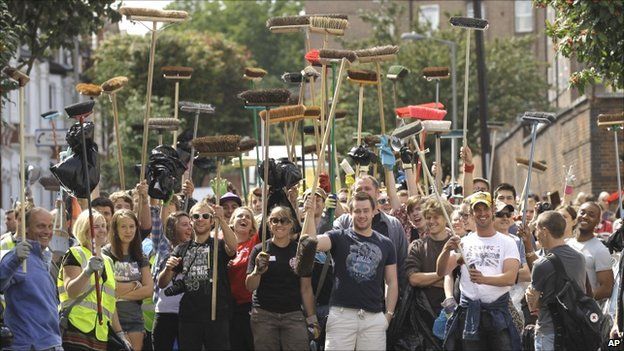England riots: Are brooms the symbol of the resistance?
- Published

In the wake of the riots in English cities, law-abiding citizens have been picking up brooms and brushes and joining the clean-up. Is the broom the symbol of the resistance to the riots?
After the rioting every night this week, the news headlines told a bleak story of communities under attack. But hours later locals wearing wellies and washing up gloves were reclaiming the streets with brooms, bin bags and dustpans.
The fightback has been co-ordinated by the Twitter campaign #riotcleanup, launched by Dan Thompson and Sophie Collard, two strangers who were united by a shared sense of outrage at the scenes of devastation.
"The most shocking thing was the TV footage of fires spreading across London," says Thompson, an artist in Worthing. "The pictures of the furniture warehouse in Croydon burning was like something out of the Blitz."
The response to the Twitter campaign was dramatic. By the following morning crowds of people had gathered in riot-affected areas like Clapham Junction and Hackney.
When London Mayor Boris Johnson went to inspect the damage in Clapham Junction, the crowd chanted "where's your broom" and one was soon pushed into his hand.
He raised it aloft to cheers that seemed to recognise the new symbol of the fightback.
Most of those involved in the clean-up brought along their own gear. But Homebase in Battersea gave away a number of brooms, dustbin bags and dustpans and brushes, and also sold some items half price to those taking part in the clean-up.
Nicole Wevers waited patiently with hundreds of other residents while police forensics experts combed the streets around the looted Debenhams in Clapham Junction.
"It was the most hilarious scene with everyone wearing marigolds and children holding mini brooms." There was a Mexican broom wave and spontaneous applause for the police and fire brigade, she says.
When the police cordons finally came down it only took 10 minutes to leave St John's Road spotless such was the turnout. "I was so upset in the morning about the riots," Wevers says. "But it was the most amazing day with a real spirit of togetherness."
The main problem was broken glass from shopfronts but not all the shops had been targeted. While the looters had cleared out the stock of Currys, Claire's Accessories and Phones4U, nearby Waterstone's had been left "without a scratch", she says.
Lucy Inglis, a 34-year-old historian, helped the clean up near Hackney Town Hall.
"There must have been about 500 of us. I was amazed - cleaning up is not a glamorous thing. You don't really want to do it in your own home let alone in the streets."
The hardest thing was cleaning up the remains of burnt-out cars. "There's this burnt metal which is very friable and a horrible sticky oil. But people were removing it with shovels and brooms."
Inglis believes the broom is the perfect symbol for the civilised majority.
If one's being pedantic the brooms are in fact brushes. "A broom is softer," she says, but the word doesn't carry the same reassuring tone. "It's great to see so many people with brooms. It's really ordinary and domestic and conjures up the sanctity of the home. A new broom sweeps clean what has gone before."
The clean-up campaign has spread across the country as quickly as the riots have. Anna Mason, 16, spent a morning sweeping up in the Wavertree area of Liverpool after reading about it on Facebook.
"I was sick of the senseless smashing up of our own communities. It's good to see there's a real sense of community with people from all over Liverpool - a vicar, mums and students - coming to help."
They won't stop the violence from happening again, she says. But by picking up the mess they are showing that they care about their community.
A community is forged on shared values. So, it's understandable that local residents are keen to mobilise for a clean up, says Tony Cassidy, a psychologist at the University of Ulster.
The immediate urge is to remove the damage that resembles an "ugly stain" on their neighbourhood. But removing the wreckage is only the first step, argues Cassidy, who specialises in how communities respond to crisis.
At many of the gatherings there were far more volunteers than could find a practical use. But more important than the physical clean-up is the feeling of a shared response.
"The riots would have left many people with a sense of helplessness. The clean-up is more about coming together to make a public demonstration that they're taking control, than taking any particular action."
Times journalist Caitlin Moran says there's something very British about the clean-up movement.
"An American said to me, we're not going to change the way we think about you until you stop clearing up after your riots. No-one else does it. We riot and then we mop it up with a napkin."
It's one thing to share a horror of the violence but now people are united by a shared purpose of clearing up their neighbourhoods. Moran has a friend staying who was scared about living on her own during the riots.
And she has read of people on Twitter collecting clothes and food for people made homeless by the fires.
"We've gone from being terrified to being united. It's a lovely sign that Britain is still Britain. People are making the best of it."